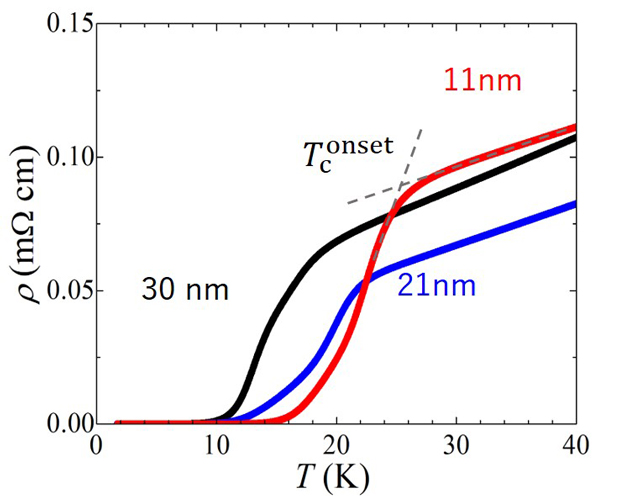PC8-5
Superconductivity in ultrathin films of FeSe on SrTiO3 grown by the PLD technique
*Tomoki Kobayashi1, Hiroki Ogawa1, Naoki Shikama1, Fuyuki Nabeshima1, Atsutaka Maeda1
- The University of Tokyo, Japan1
Iron chalcogenide superconductor, FeSe, has attracted much attention for high tunability of the superconducting transition temperature (Tc). Although Tc of FeSe is 8 K in bulk form, it increases up to approximately 40 K by applying hydrostatic pressure, intercalation etc. Furthermore, ARPES measurements reported that a monolayer epitaxial film grown on SrTiO3 (STO) substrate shows superconductivity [1] with Tc as high as 65 K [2]. The high Tc in the monolayer FeSe/STO is attributed to interface effects such as electron doping from STO substrate and electron-phonon interaction via the substrate. One important problem in the high Tc superconductivity in monolayer FeSe/STO is discrepancy in reported values of Tc depending on the measurement techniques. The 65 K Tc was reported by ARPES measurements. However, almost all of resistivity measurements reported the onset Tc (Tconset) of about 40 K and much lower zero-resistance Tc (Tczero) [1,3]. The only exception is the report of 109 K Tczero by Ge et al.[4], for which a skepticism was proposed in terms of reproducibility and reliability [5]. The disagreement between resistance Tc and those obtained by ARPES measurements casts a question whether the real Tc in monolayer FeSe/STO is 65 K or not. We have worked on the growth of epitaxial thin films of FeSe by a pulsed laser deposition (PLD) technique [6]. We investigated electron doping effect by fabricating electric double layer transistor (EDLT) structure on the films, and found that even only electron doping increases Tczero up to 46 K [7,8]. This is the highest Tczero of FeSe ever reported including monolayer FeSe/STO except for ref. [4]. Thus, it is intriguing how Tc of FeSe films grown by PLD changes as the thickness of FeSe films is reduced. It should be noted that all reports of high Tc in monolayer FeSe/STO is obtained in films grown by molecular-beam epitaxy (MBE). It might be possible that Tczero of monolayer FeSe/STO is higher than those ever reported when fabricated by PLD. In this work, we report growth and transport properties of FeSe/STO ultrathin films by the PLD technique.
Prior to the deposition, the STO substrates were thermally treated so that the step and terrace structure on the surface was observed. This is very important to obtain films with good superconducting properties. Fig. 1 shows the temperature dependence of resistivity for three films with different thicknesses, namely 30 nm, 20 nm, and 11 nm. All films show superconducting transition at low temperatures. Tconset increases as the thickness is reduced, and the 11-nm-thick film shows the highest Tconset = 26 K and Tczero = 11 K. These results are remarkable since these Tconset values are exceptionally high in terms of the relationship between Tc and in-plane strain reported for bulk superconductivity in FeSe films [9]. All of these films have in-plane lattice constant, a ≧ 3.77 Å, leading to Tc < 8K according to the relationship reported in ref. [9]. In addition, the behavior that Tconset increases with decreasing thickness is in good agreement with those of MBE-grown films [10] even quantitatively. These results indicate that the high Tc in the grown films is the result of the interface effects other than the lattice strain. In other words, we succeeded in realizing interface superconductivity in FeSe/STO by the PLD technique for the first time.
In the presentation, we will also show results of thinner films.
Figure 1 : Temperature dependence of resistivity for 30, 20, 11 nm films of FeSe/STO
References
[1] Q. Y. Wang et al., Chin. Phys. Lett. 29, 037402 (2012)
[2] S. He et al., Nat. Mater. 12, 605 (2013)
[3] A. K. Pedersen et al., Phys. Rev. Lett. 124, 227002 (2020)
[4] J. F. Ge et al., Nat. Mater. 14, 285 (2014)
[5] I. Bozovic and C. Ahn, Nat. Phys. 10, 892 (2014)
[6] Y. Imai, F. Nabeshima, A. Maeda Condens. Matter 2, 25 (2017)
[7] N. Shikama et al., Appl. Phys. Express 13, 083006 (2020)
[8] N. Shikama et al., Phys. Rev. B 104, 094512 (2021)
[9] F. Nabeshima et al., JJAP 57, 120314 (2018)
[10] Q. Wang et al., 2D Mater. 2, 044012 (2015)
Keywords: Iron chalcogenide, Pulsed laser deposition, Supercondutivity, ultrathin films
